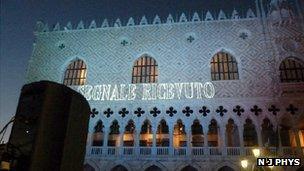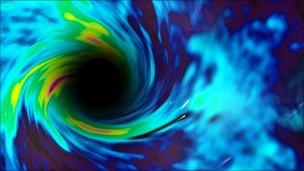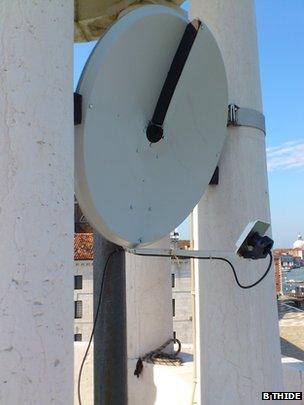'Twisted' waves could boost capacity of wi-fi and TV
- Published

In a public event in 2011, Venice's Palazzo Ducale lit up with "signal received" when the test worked
A striking demonstration of a means to boost the information-carrying capacity of radio waves has taken place across the lagoon in Venice, Italy.
The technique exploits what is called the "orbital angular momentum" of the waves - imparting them with a "twist".
Varying this twist permits many data streams to fit in the frequency spread currently used for just one.
The approach,described in the New Journal of Physics, external, could be applied to radio, wi-fi, and television.
The parts of the electromagnetic spectrum that are used for all three are split up in roughly the same way, with a spread of frequencies allotted to each channel. Each one contains a certain, limited amount of information-carrying capacity: its bandwidth.
As telecommunications have proliferated through the years, the spectrum has become incredibly crowded, with little room left for new means of signal transmission, or for existing means to expand their bandwidths.
But Bo Thide of Swedish Institute of Space Physics and a team of colleagues in Italy hope to change that by exploiting an entirely new physical mechanism to fit more capacity onto the same bandwidth.
Galilean connection
The key lies in the distinction between the orbital and spin angular momentum of electromagnetic waves.

The orbital angular momentum of light may also manifest itself in what we see from black holes
A perfect analogy is the Earth-Sun system. The Earth spins on its axis, manifesting spin angular momentum; at the same time orbits the Sun, manifesting orbital angular momentum.
The "particles" of light known as photons can carry both types; the spin angular momentum of photons is better known through the idea of polarisation, which some sunglasses and 3-D glasses exploit.
Just as the "signals" for the left and right eye in 3-D glasses can be encoded on light with two different polarisations, extra signals can be set up with different amounts of orbital angular momentum.
Prof Thide and his colleagues have been thinking about the idea for many years; last year, they publishedan article in Nature Physics, externalshowing that spinning black holes could produce such "twisted" light.
But the implications for exploiting the effect closer to home prompted the team to carry out their experiment in Venice, sending a signal 442m from San Giorgio island to the Palazzo Ducale in St Mark's square.
"It's exactly the same place that Galileo first demonstrated his telescope to the authorities in Venice, 400 years ago," Prof Thide told BBC News.
"They were not convinced at all; they could see the moons of Jupiter but they said, 'They must be inside the telescope, it can't possibly be like that.'
"To some extent we have felt the same (disbelief from the community), so we said, 'Let's do it, let's demonstrate it for the public.'"
Marconi style
In the simplest case, putting a twist on the waves is as easy as putting a twist into the dish that sends the signal. The team split one side of a standard satellite-type dish and separated the two resulting edges.

The relatively crude antenna could be replaced with more sophisticated signal processing
In this way, different points around the circumference of the beam have a different amount of "head start" relative to other points - if one could freeze and visualise the beam, it would look like a corkscrew.
In a highly publicised event in 2011, the team used a normal antenna and their modified antenna to send waves of 2.4 GHz - a band used by wi-fi - to send two audio signals within the bandwidth normally required by one. They repeated the experiment later with two television signals.
Crowds were treated to projections beamed onto the Palazzo Ducale explaining the experiment, and then a display of the message "signal received" when the experiment worked.
Prof Thide said that the public display - "in the style of (radio pioneer) Guglielmo Marconi... involving ordinary people in the experiment", as the authors put it - was just putting into practice what he had believed since first publishing the idea ina 2007 Physical Review Letters article, external.
"For me it was obvious this would work," he said. "Maxwell's equations that govern electromagnetic fields are... the most well tested laws of physics that we have.
"We did this because other people wanted us to demonstrate it."
Prof Thide and his colleagues are already in discussions with industry to develop a system that can transmit many more than two bands of different orbital angular momentum.
The results could radically change just how much information and speed can be squeezed out of the crowded electromagnetic spectrum, applied to radio and television as well as wi-fi and perhaps even mobile phones.
- Published14 February 2011
- Published1 March 2012